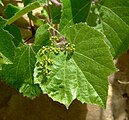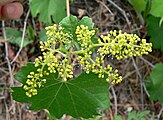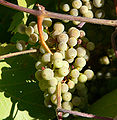Vitis arizonica
 From Wikipedia the free encyclopedia
From Wikipedia the free encyclopedia
| Arizona grape | |
|---|---|
 | |
| Arizona grape in Icebox Canyon, Spring Mountains, southern Nevada | |
| Scientific classification | |
| Kingdom: | Plantae |
| Clade: | Tracheophytes |
| Clade: | Angiosperms |
| Clade: | Eudicots |
| Clade: | Rosids |
| Order: | Vitales |
| Family: | Vitaceae |
| Genus: | Vitis |
| Species: | V. arizonica |
| Binomial name | |
| Vitis arizonica | |
| Synonyms[1] | |
| |
Vitis arizonica is a North American species of wild grape. It is a deciduous vine.
Common names for the grape are Arizona grape, canyon grape, and uva del monte.[2] It has historically been used as a food source by Indigenous peoples of the Southwest. Canyon grape can tolerate drought and cold temperatures. It grows in a variety of habitats including riparian zones and shady canyons.[3] It can hybridize with mustang grape, sweet mountain grape, and California wild grape where their ranges overlap.[4]
Etymology
[edit]Vitis is Latin for "vine", while arizonica means "of or from Arizona". The plant was described by George Engelmann in 1871.[5]
Distribution
[edit]Arizona grape is found in California (Inyo County), Arizona, Nevada, New Mexico, western Texas, southern Utah, Sonora, Chihuahua, Coahuila, Durango, and Tamaulipas.[1] Within Arizona, Vitis arizonica is found in all counties, except La Paz.[6][7][8]
Morphology
[edit]Form: Vine General: Woody vine, sprawling or weakly climbing; stems generally 2–6 m long; the young twigs densely woolly, but losing this over time and the bark becoming shreddy. Leaves: Winter deciduous; broadly cordate, 3–10 cm long and about as wide, irregularly toothed and sometimes shallowly 3-lobed, more-or-less cottony hairy; petiole 1–3 cm long; tendrils opposite the leaves, bifurcate, lacking adhesive discs, withering quickly if not attached to something. Flowers: Inflorescence a loose, open, strongly branched panicle, 2–10 cm long, emerging opposite the leaves; flowers tiny with five, white petals. Fruits: Edible (but sometimes bitter) grapes, 8–10 mm thick, black.[2]
The canyon grape is a vigorously branching vine. Stems are slender, with significant tapering from base to apex. Fully developed leaves resemble a three-lobed heart shape and generally grow to an average of 4 inches long/wide. Leaves exhibit irregular toothed edge. Green flower buds develop in clusters, and small flowers bloom in a whitish green hue. Globe or ovate shaped fruit are typically 1/3-3/8 in diameter; immature fruit is green in color, developing into a deep purple or black. Fruit are clustered on red pedicels.[9]
Uses
[edit]Vitis arizonica has been used in breeding varieties resistant to Pierce's Disease.[10] Canyon grape is edible with different individual plants being sweet and others being bitter. The fruit can be used for wine making and jams, but is mainly consumed by wildlife.[2] It is consumed by both birds and mammals. Canyon grape has historically been used as a food source by many Indigenous peoples. Historically it was cultivated by the Pueblo, and was eaten both fresh or dried. Other tribes consumed it as well, such as the Chiricahua and Mescalero Apache. [5] Both Native Americans and early European settlers would chew on grape leaves to quench their thirst. Aside from food, it was also used by the Havasupai to make toys, used by the Navajo in courtship rituals, and was used by the Jemez to make ritual items.[5]
Gallery
[edit]- Vitis arizonica
References
[edit]- ^ a b c Species was first published in Amer. Naturalist 2:321. 1868 "Vitis arizonica". Germplasm Resources Information Network. Agricultural Research Service, United States Department of Agriculture. Retrieved May 12, 2010.
- ^ a b c d "SEINet - Arizona Chapter - Vitis arizonica". swbiodiversity.org. Archived from the original on Aug 15, 2022. Retrieved May 4, 2017.
- ^ "Search Tree Collections". apps.cals.arizona.edu. Archived from the original on Aug 28, 2023. Retrieved 2024-02-26.
- ^ "Vitis arizonica". www.fs.usda.gov. Archived from the original on Aug 1, 2022. Retrieved 2024-02-26.
- ^ a b c "Grafting the Grape: Indigenous Use of Grapes". Missouri Botanical Garden. 2021-10-05. Archived from the original on June 6, 2023. Retrieved 2024-02-26.
- ^ "USDA Plants Database". plants.usda.gov. Retrieved 2024-02-26.
- ^ "Vitis arizonica map". The Biota of North America Program. Archived from the original on Jan 24, 2024.
- ^ "Tropicos". www.tropicos.org. Archived from the original on Nov 21, 2022. Retrieved 2024-02-26.
- ^ Littlefield, Larry J.; Burns, Pearl M. (2015). Wildflowers of the Northern and Central Mountains of New Mexico: Sangre de Cristo, Jemez, Sandia, and Manzano. Albuquerque: University of New Mexico Press. p. 360. ISBN 9780826355478.
- ^ Kyrkou, Ifigeneia; Pusa, Taneli; Ellegaard-Jensen, Lea; Sagot, Marie-France; Hansen, Lars Hestbjerg (2018-09-12). "Pierce's Disease of Grapevines: A Review of Control Strategies and an Outline of an Epidemiological Model". Frontiers in Microbiology. 9: 2141. doi:10.3389/fmicb.2018.02141. ISSN 1664-302X. PMC 6143690. PMID 30258423.






